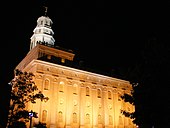Nauvoo Temple
The Nauvoo Temple was after the Kirtland Temple , the second temple , that of the Church of Jesus Christ of Latter-day Saints was built. When the majority of Church members were forced to leave Nauvoo in the winter of 1846 , the Church sold the building in 1848. The structure was largely destroyed by arson and a tornado before it was abandoned.
In 1937 the church bought the former temple grounds again. In 2000 she began building a temple there, the shell of which is an exact replica of the destroyed temple, the interior of which, however, was designed like a modern temple of the LDS church. The temple was dedicated as the Nauvoo Illinois Temple on June 27, 2002, the date of the 158th anniversary of the murder of Joseph Smith .
history

When the Mormons established their headquarters in Nauvoo in 1839, they were also making preparations to build a temple. On April 6, 1841, Joseph Smith laid the foundation stone . Sidney Rigdon gave the dedication address.
At the base the building was 39 meters long and 27 meters wide, with a clock tower and a wind direction transmitter it reached a height of 50 meters - an increase of 60% compared to the Kirtland Temple. Like the Kirtland Temple, the Nauvoo Temple had two meeting halls, one on the lower floor and one on the upper floor, which were referred to as the lower or upper court. Both had classrooms and offices in the attic. In contrast to Kirtland, the temple had a complete basement with a baptismal font .
The temple was designed in the style of the Greek Revival by the architect William Weeks. Weeks used special Mormon motifs such as sun stones, moon stones, and star stones. It is mistakenly believed that these motifs represent the kingdoms of glory . However, the stones are in the wrong order. Instead, the stones should refer to the verse in ( Rev 12,1 EU ) and point to the woman. The woman is "clothed with the sun, has the moon under her feet and wears the crown of the twelve stars".
The temple was only halfway through when Joseph Smith was murdered. When Brigham Young was named president of Nauvoo, he encouraged members to continue building the temple so that it could be used for baptisms , sealing, and endowment . The temple was operational for less than three months.
On March 11, 1848, the LDS Church sold the temple to David T. LeBaron for $ 5,000. On the evening of 8./9. In October 1848 a fire was set in the temple; Extinguishing attempts were unsuccessful. On April 2, 1849, LeBaron sold the damaged building to Étienne Cabet for $ 2,000. Its followers, the Icarians , wanted to create a communist paradise there.
destruction
After the fire, only the four foundation walls remained . Cabet, the leader of the Icarians, was fascinated by the temple and wanted to rebuild it. He invested a considerable amount of money in this venture. However, on May 27, 1850, Nauvoo was hit by a tornado that tore down one wall of the temple. An eyewitness claimed that "the tornado was after the temple" and "the fall of the walls could be heard from miles away." Cabet ordered two more walls to be demolished in the interests of public safety. Only the facade remained. The followers of Cabet used stones from the temple to build a new school building. By 1857, however, many of Cabet's followers had left the city and the remaining stones of the temple were used to build other buildings in Hancock County . In February 1865, the Nauvoo City Council ordered that the last parts of the temple be demolished. Soon afterwards, all references to the temple disappeared except for a hand pump that supplied water to the baptismal font. Of the last three preserved sunstones, one is in the Visitor Center for Latter-day Saints' Church of Jesus Christ in Nauvoo, one in the Smithsonian Institution Building in Washington, DC, and one, along with the last preserved moonstone, is in the Joseph Smith Fellowship of Christ History Center .
Nauvoo Illinois Temple
In 1999, Church President Gordon B. Hinckley announced that the temple would be rebuilt on its original site. After two years of construction, the inauguration took place on June 27, 2002.
Further literature
Web links
- Nauvoo Illinois Temple on Latter-day Saint Church of Jesus Christ website (accessed July 28, 2017)
Individual evidence
- ^ Laurel B. Andrew: The Early Temples of the Mormons: The Architecture of the Millenial Kingdom in the American West . State University of New York, Albany, New York 1978, ISBN 978-0-87395-358-0 , pp. 12 (American English, preview on Google Books ).
- ^ A b Lisle Brown: Chronology of the Construction, Destruction, and Reconstruction of the Nauvoo Temple. In: Marshall University Personal Web Pages. Retrieved July 28, 2017 (American English).
- ↑ Virginia S. Harrington, JC Harrington: Rediscovery of the Nauvoo Temple; report on the archaeological excavations . Nauvoo Restoration, Salt Lake City 1971, OCLC 247391 , p. 5 (American English).
- ^ Henry Horner: Illinois, A Descriptive and Historical Guide ( English ). Federal Writer's Project of the Work Projects Administration for the State of Illinois, Chicago 1939, p. 352.
- ↑ Jan Dennis: Mormon temple a tourism draw for tiny Nauvoo. In: usatoday.com . August 22, 2006, accessed March 15, 2020 .




